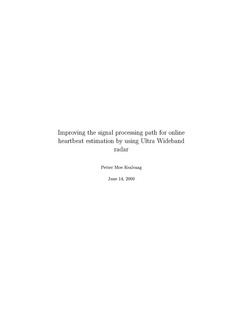| dc.contributor.author | kvalvaag, Petter Moe | |
| dc.date.accessioned | 2009-10-29T10:00:47Z | |
| dc.date.issued | 2009 | |
| dc.identifier.uri | http://hdl.handle.net/11250/181669 | |
| dc.description | Master's thesis in Cybernetics and signal processing | en |
| dc.description.abstract | A number of companies, research establishments and universities worldwide
are currently researching the use of Ultra Wideband radar technology to
conduct non-contact and non-invasive measurements of heartbeat.
Both cardiac and respiratory activity cause a visible and measurable
motion to the chest wall. When aiming a radar to a subject's chest, this
motion can be recorded and processed to obtain the rates of respiration and
heartbeat.
This thesis looks into the processing of chest wall displacement data to
improve heart rate measurements. At the first stage of the signal processing,
the low frequency, high amplitude respiration signal component must
be separated from the much smaller heartbeat component. Traditionally,
linear Finite Impulse Response (FIR) highpass filters have been used to remove
the respiration component. FIR filters have a fixed corner frequency.
If the respiration rate is higher than this fixed frequency, FIR filtering can
not work. In addition, FIR filters must be quite long for suficient stopband
attenuation, and thus they introduce a time delay to the system. Alternative
signal processing techniques are based on cancellation of respiration
harmonics, which eliminates the system delay and works at any respiration
frequency. One such method from the literature was investigated, and this
thesis presents a modified version that works better with actual radar data.
After separation, the heart rate must be determined. Traditionally, frequency
estimation of a sliding window has been used. A different method
from the literature is based on adaptive filtering. It transforms the heartbeat
signal into a train of unit pulses, each occurring at the start of a heartbeat.
Instant heartbeat information is thus gathered, as opposed to the traditional
method which yields the mean heart rate during the time window.
Some system results were obtained for both constructed test signals and
actual radar data. Generally FIR filtering performed better than harmonic
cancellation, but the harmonic canceller outperformed FIR filtering when the
respiration frequency tended towards the filter's corner frequency. Feasibility
of a system that gives instant heart rate measurements in real-time was
proven. The improvements on traditional systems are elimination of time
delay, enabling separation at high respiration frequencies and giving the
instant heart rate rather than an avereraged one. | en |
| dc.format.extent | 962419 bytes | |
| dc.format.mimetype | application/pdf | |
| dc.language.iso | eng | en |
| dc.publisher | University of Stavanger, Norway | en |
| dc.relation.ispartofseries | Masteroppgave/UIS-TN-IDE/2009 | en |
| dc.subject | kybernetikk | en |
| dc.subject | signalbehandling | en |
| dc.title | Improving the signal processing path for online heartbeat estimation by using Ultra Wideband radar | en |
| dc.type | Master thesis | en |
| dc.subject.nsi | VDP::Mathematics and natural science: 400::Information and communication science: 420::Simulation, visualization, signal processing, image processing: 429 | en |
